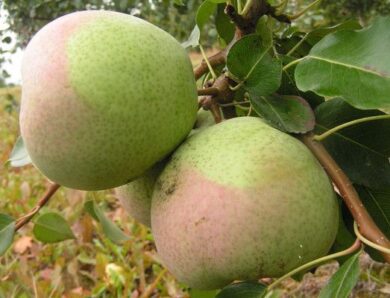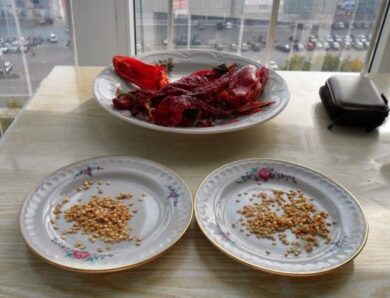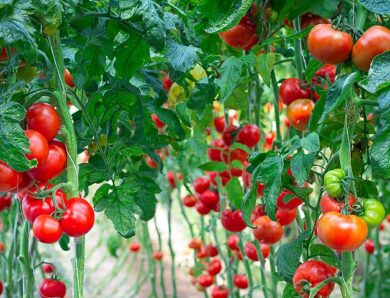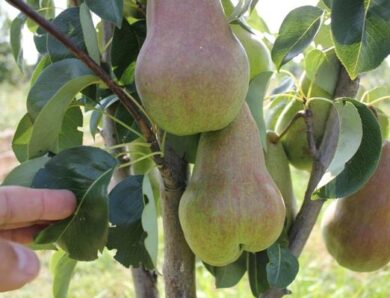Growing peppers in a greenhouse: all, what a gardener needs to know
Sweet pepper is very heat-loving and demanding, therefore, it is easier to grow in greenhouses, than in the open ground. Growing peppers in a greenhouse is a guarantee of that, that the plants will not freeze at night, and at the end of the season will harvest. However, the quality and quantity of this crop will depend entirely on the creation of a favorable microclimate and care of the bed. About that, how to grow peppers in a greenhouse and what important points need to be considered in this process, you will learn from the article.
variety selection
The cultivation of any crop begins with the choice of varieties, and they are now presented to sell a huge number. Pepper varieties have a fairly broad classification:
- in terms of maturation: ultra-early, early ripening, medium-ripe, late, very late;
- under growing conditions: for greenhouses, for open ground, for film shelter;
- in the form of bushes: short, medium-sized and tall;
- on the color of the fruit.
For planting in a greenhouse, choose only greenhouse varieties. They are more resistant to weather factors, less sick, capable of self-pollination. If you are a true connoisseur of this vegetable, then plant several varieties of different colors and fruits of ripening. To harvest in the greenhouse in June, choose ultra-early varieties, fruitful through 90-100 days: Health, Mustang, Oriole, Cardinal F1, Fidelio F1, Orange wild.
If the greenhouse is small, then stop your choice on low-growing compact plants: Eroshka, Turquoise, Flamingo, cabin boy, Victoria. The real decoration of the greenhouse and your table will be unusual hybrids with bright purple fruits, bred relatively recently: Black cardinal, East star F1, Purple, Purple baron.
Video "Best varieties"
In the video you will learn about the best varieties of peppers.
Planting and obtaining seedlings
Such a heat-loving culture, like pepper in our latitudes, even in greenhouses, grown only through seedlings. Seeds should be sown 2 months before planting in the garden - from about late February to mid-March. The process of growing seedlings consists of the following main stages:
- preparation of planting containers with substrate;
- preparation of seeds for sowing
- sowing seeds;
- and further care after emergence of sprouts.
Now about everything in order. For planting seeds it is better to take disposable containers (from them it will be easier to get seedlings together with the earth), but you can also use boxes or containers. Pepper is very demanding on soil composition, therefore the substrate must be fertile, enriched with humus. The soil mix will be ideally suited, consisting of earth and humus or compost in proportion 1: 1.
Seeds should be disinfected and germinated before planting. To do this, select the largest and most complete seeds, place them in a solution of manganese on 30 minutes, then rinse well with water. Next out 2 Art. spoons of salt and 1 l of water prepare a solution, where to put the seeds on 10 minutes. All pop-up copies are discarded, and those, sunk to the bottom, washed and slightly dried on a sheet of paper.
After that, soak the seeds again for a day in any stimulant: ash solution, aloe juice, special solutions with humic acids. Then place them in damp gauze and keep until the shell opens. The seeds hatched on 2-3 pieces immediately sow in moist substrate to a depth 1 cm. If planting is done in containers, then the seeds are planted at a distance 2-3 see each other. After planting, the container should be covered with glass or film and put in a warm place.
Pepper seeds germinate through while maintaining soil moisture 2-3 weeks, but for this the air temperature must be at the same level 20-25 ° C. When the stairs appear, the glass must be removed, and put the containers in a bright place (on the windowsill). Further care of seedlings consists of regular watering and fertilizing with liquid organic fertilizer 1 once / 2 weeks. Plants in a container with the appearance of two true leaves dive into separate containers, and those, growing in disposable pots, thin out, leaving 1 the strongest sprout. Aged 60 days seedlings are transplanted permanently in the greenhouse.
Basic rules of cultivation
In temperate climates, pepper is planted in a greenhouse in mid-May. If the greenhouse is stationary and heated, then planting can be carried out a month earlier. You should not try to grow vegetables all year round or in winter. Since pepper is a southern culture, for the yield of which heat and the length of daylight are crucial.
Because peppers are grown through seedlings, then the quality and readiness of seedlings for planting need special attention. Though, that in appearance pepper seedlings seem quite strong, when transplanting, she experiences great stress, therefore, only mature and prepared seedlings can be planted in the greenhouse. You can determine the readiness of seedlings for transplanting on the following grounds:
- uniform deep green color of leaf plates;
- powerful and thick stem;
- availability 10-12 real leaves;
- the presence of developing buds in the axils of the leaves;
- height not less 20 cm (ideally 25-30 cm);
- age 55-60 days from sowing seeds.
Such seedlings are guaranteed to take root in the greenhouse and in the shortest possible time will be able to enjoy flowering, and then fruiting. But before planting it, it is necessary to prepare a bed:
- at the time of planting the soil should warm up to 15-18 ° C;
- for 2-4 weeks before planting seedlings bed should be dug up and fertilize at the rate of 1 m ?: humus or compost 1-2 buckets, potassium chloride 30 G, superphosphate 50 g and ammonium nitrate 40 d - this is provided, that after the last harvest the soil was disinfected.
Seedlings are planted according to the scheme, the choice of which depends on the varietal characteristics of peppers. Tall plants are recommended to be planted at the rate 4-5 bushes / 1 m? landing area. The distance between the seedlings should be at least 40 cm, and in between rows 70-80 cm. For low-growing shrubs allowed a denser planting - up to 6 bushes / m? at a distance 30-35 between plants and 60-70 between the rows. After planting the plants should be well watered, and cover the soil with mulch.
When growing peppers in greenhouses, it is necessary to create the most favorable microclimate:
- The length of daylight for plants should be 12 hours. Deviations from this norm can lead to leaf drop and cessation of flowering, therefore, on cloudy days, seedlings need to be illuminated, and in very sunny weather to shade.
- The temperature in the greenhouse should be regulated depending on the period of seedling development. The temperature is considered optimal before flowering 25-28 ° C. You need to watch during flowering, so that this threshold is not exceeded, as this can cause the flowers to drop and ovaries to form. Importantly, so that the difference between day and night temperature does not exceed 5 ° C.
- Watering should be moderate, but regular. For lack of moisture, as well as its excess, plants respond to leaf drop.
- Air humidity. For peppers is considered comfortable humidity level 65-75%. Peppers also react to a sharp change in these indicators by losing leaves, ovaries and deterioration of the fruit. in addition, at high humidity fungal diseases begin to develop.
- Peppers are often needed for intensive development (at least 1 times / 2 weeks) feed up. For this purpose it is better to use natural organic fertilizers: mullein or infusion of grass, popularly called "green tea", which are made by watering the roots. From time to time you can spray the bushes with boric acid.
- To improve the quality and quantity of fruit, it is recommended to pluck the first buds during flowering. This procedure helps to strengthen the bush, then it will give more flowers and ovaries. Peppers in greenhouse conditions must be tied to a support, even if the bushes are short. It has to do with that, that the pepper branches are quite fragile, and that they do not break under the weight of the ripening fruit, it is better to tie each escape to the wallpaper.
Diseases and pests
Like any vegetable crop, peppers in the greenhouse can be damaged by diseases and pests. The most common diseases of this culture are:
- Phytophthora. Phytophthora fungus is the most insidious enemy of nightshade plants, which include pepper. It is manifested by dark spots with a light outline on the leaves, gradually leads to the defeat of all parts of the bush and fruit rot. It develops in greenhouses against the background of humidity and temperature fluctuations. To prevent peppers, it is recommended to treat with Bordeaux mixture, and during the disease Fitosporin.
- Black leg. Fungal disease, affecting the lower part of the stem, which leads to the death of roots, and then the whole bush. The disease quickly spreads to neighboring bushes, so for 3-4 days all plants can get sick. The only way to prevent infection is to destroy the diseased bush. Prevention measure - disinfection of the soil before planting.
- Bacterial spot. The fungus is manifested by putrefactive watery spots on all parts of the plant, and if it bears fruit, even on the fruit. As an immediate help, the bushes are recommended to treat with any antifungal agent, and replace the soil after harvest.
- White rot. Fungal disease is quite common for greenhouse peppers. It is manifested by soft spots with a white coating on the leaves, starting from the top of the bush. At the same time the stalk becomes thinner, which leads to the gradual death of the plant. Control measures - treatment with copper-containing drugs (Hom, copper sulphate). The greenhouse should be regularly ventilated, and suspend watering and application of nitrogen fertilizers.
- Fusarium wilt (withering). The plant can be affected at any age. Manifested by yellowing and wilting of the upper leaves, darkening and drying of stalks with peppers. The only preventive measure is to disinfect the seeds before planting. Sick plant should be removed from the bed as soon as possible and burned.
Pepper, planted in a greenhouse, also often affected by pests. Greenhouses are considered to be the most active pests in greenhouse conditions (greenhouse) whiteflies, spider mites, blacksmith beetles and their wire larvae.
Whiteflies and mites can be got rid of only with the help of insecticides: Phosphate, aktellika, Carbophos. Wireworms live in the ground, so they need to be obtained through traps: pieces of raw potatoes are poured into the pits, and a few days later the larvae crawl there. At high humidity in the greenhouse snails are often found. They can be removed from the pepper with lime, mustard powder or ash, which are scattered between rows.
Harvesting
Greenhouse peppers are harvested at different times, which is determined by the varietal characteristics of the culture. Another important thing is the degree of fruit maturity, which happens:
- technical. Comes on 35-45 days after ovulation, at this time the fruits have already reached their maximum size, but still remain immature;
- biological. The fruits have reached full maturity: found a characteristic color for the variety, taste and juiciness, and the seeds inside are fully ripe.
Peppers, filmed at technical maturity, ripen well in a cool dry place (10-12 ° C) and stored for up to two months, therefore, it is recommended to remove vegetables from the bush for storage at this stage. Fruit collection should be done carefully, as the bushes are very fragile. It is better to cut the pepper together with the stalk, this will continue to store the vegetables and prevent the branches from breaking off. Because the fruits ripen gradually, on 2-3 pieces a day on each bush, then the harvest should be carried out as the peppers ripen - from mid-July to September, and sometimes longer.
For immediate consumption and collection of seeds, it is recommended to keep peppers on the bushes until full biological maturity.. Such vegetables are tastier, juicy and fragrant, but they do not last long. If your goal is to get seeds, then you should choose some of the largest and highest quality fruits from the lower tier of the bush, put them in a warm dry place and wait, until the skin dries. Fruits for seed can also be left to ripen on the bushes until late autumn, in this case, the seed will be even better.
In late autumn, ripe fruit is removed from the bush, placed in a paper bag and stored there until the skin dries. Then the dried pepper is cut, the seeds are removed, and then stored in a paper or cotton bag until dry. Dry seeds are packed, be sure to indicate the name of the variety and the year of harvest. The shelf life of seeds is 3 years, however, older material can give a strong ladder.
Video "Growing and care"
You will learn from the video, how to grow and care for peppers.




